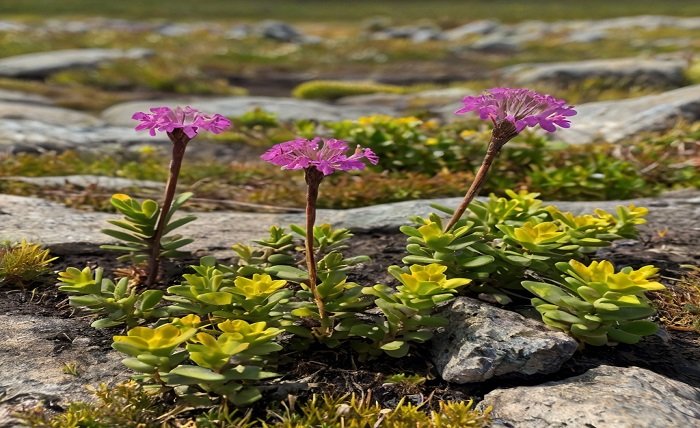Plants in the tundra: Despite being one of the coldest places on Earth, the tundra is home to an incredible variety of plant life. The tundra’s plants have evolved amazing adaptations to endure and flourish despite the severe cold, powerful winds, and deficient nutrient condition of the soil. Let’s investigate these hardy flora and the intriguing tactics they use to thrive in such a harsh environment.
The Tundra: What Is It?

Permafrost, a layer of earth that is permanently frozen, is a characteristic of the treeless tundra biome. This biome is found worldwide at high altitudes in mountains, including the Arctic. The growing season is frequently quite brief, lasting only a few weeks, and the climate is frigid, with frequent lows below freezing. The tundra is home to a distinctive range of plant species despite these conditions.
Survival Adaptations
Many adaptations have been developed by plants in the tundra to withstand the harsh environment. Among them are:
Low-Growing Forms: A lot of tundra plants grow low to the ground, which protects them from wind damage and helps them retain heat.
Drought Resistance: The soil in the tundra is typically extremely dry, despite the region’s frequent covering of snow and ice. Plants on the tundra have evolved to effectively store water.
Dark Pigmentation: To absorb more heat from the sun, several plants have dark leaves.
Common Plants in the Tundra
The tundra is home to several different plant species, all of which are important to the general health of the ecosystem:
Some of the hardiest: arctic plants are mosses and lichens, which can withstand harsh temperatures and thrive on exposed rocks.
Sedges and Grasses: These resilient plants support the tundra’s vegetation and serve as a food source for animals.
Dwarf Shrubs: Common species that have adapted to grow low to the ground include dwarf birch and Arctic willow.
Blooming Plants
Remarkably, there are many different kinds of flowering plants in the tundra. These plants flower early in the short summer season in order to make the most of their short growing season. As an example, consider:
Arctic Poppy: Rocky places are ideal for this vivid yellow flower to grow.
One of the first: plants to bloom in the spring is purple saxifrage, which is well-known for its gorgeous purple blossoms.
Environmental Significance
Important roles for tundra plants exist in the ecosystem. They give animals food and a place to live while also aiding in soil stabilization and reducing erosion. Furthermore, through sequestering carbon in the permafrost, tundra plants play a role in the carbon cycle.
Tundra plants and climate change
Ecosystems in the tundra are seriously threatened by climate change. Permafrost is melting due to rising temperatures, which may result in the loss of habitat for many tundra plants. Warmer temperatures and longer growth seasons, however, might be advantageous for some species.
Preservation Activities
To preserve biodiversity and the health of the global ecosystem, the tundra and its distinctive plant life must be preserved. Among the initiatives are:
Protected Areas: To keep tundra areas free from human encroachment, national parks and reserves are established.
Research and Monitoring: Examining tundra ecosystems to comprehend the effects of climate change and create mitigation plans.
Reducing greenhouse: gas emissions is one way to slow down the rate of global warming.
In summary
The ability of life to persevere in the face of overwhelming adversity is demonstrated by the tundra plants. They contribute to the special and sensitive ecosystem of the tundra by their amazing adaptations that enable them to thrive in one of the harshest places on Earth. Given the problems posed by climate change, it is more crucial than ever to comprehend and safeguard these hardy species.
FAQ
Which plant species are predominant in the tundra? Mosses, lichens, sedges, grasses, dwarf shrubs, and a variety of floral plants can be found on the tundra.
How can plants in the tundra withstand the harsh environment? Tundra plants have developed defense mechanisms against harsh winter weather, high winds, and dry soil, including limited growth forms, tolerance to dryness, and dark coloring.
How do tundra plants function within the ecosystem? By storing carbon in the permafrost, tundra plants aid in soil stabilization, provide food and shelter for wildlife, and participate in the carbon cycle.

